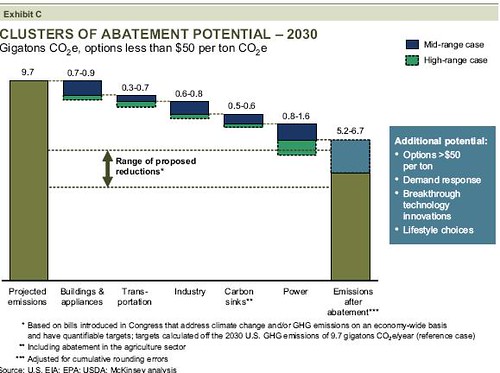
The McKinsey plan (107 page report) for lowering climate change gases in the United States
1. Energy efficiency in buildings and appliances (710-870 megatons of carbon)
2. More fuel efficient vehicles (340-660 megatons of carbon)
3. Industrial efficiency (620-770 megatons)
4. Bigger carbon sinks (like more forest) (440-580 megatons)
5. Less carbon intensive power generation (800-1570 megatons)
This last one is more nuclear power and renewables and cleaning up coal.
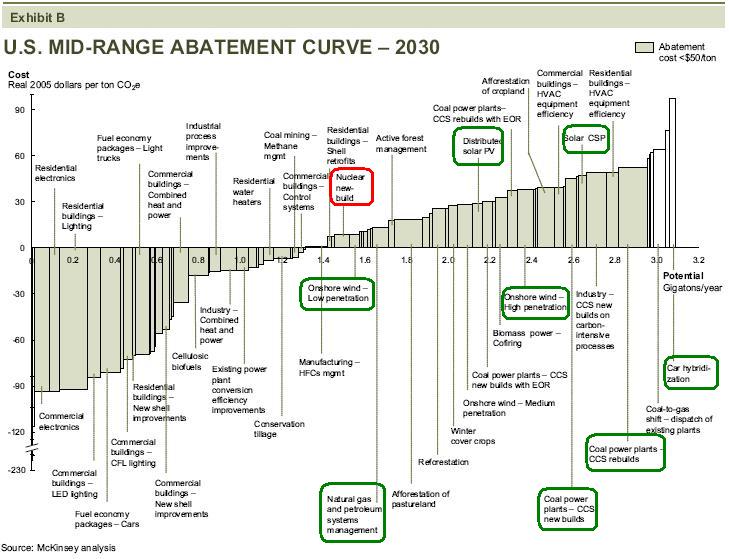
Nuclear is the cheapest of the ways to add more power. The other measures that reduce costs are greater efficiency, which should also be done
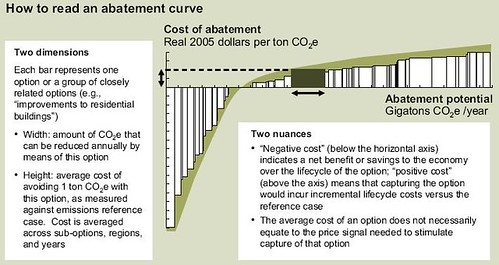
Reading the curve, Width of a box is how much effect Mckinsey estimates and height is positive or negative cost.
One of the cheapest means of offsetting carbon listed in the McKinsey report is nuclear power. New is on the carbon abatement curve at slightly cheaper than onshore wind at $9/ton. This is even with pessimistic views for the cost of new nuclear power in the report.
McKinsey argue for streamlining approval and permitting procedures for nuclear, tranmission lines and pipelines.
The report does not consider even faster shifts to nuclear power that are possible. My analysis is that nuclear in the United States can increase by 675% instead of 153%in the high McKinsey case (129% in the middle case). McKinsey estimates $3500-4000/kw for nuclear power. This is far higher than the $1400-2200/kw range of new reactors.
EIA analysis shows that nuclear power can be nearly tripled in the USA with a climate change bill that penalizes carbon (the kind of bills that are being considered in the US senate now and likely to pass in 2009).
50% power uprate technology can be deployed by 2020, not just the 2,5 and 20% standard uprates
Thermoelectric technology could increase the efficiency of electricity conversion and increase power from nuclear reactors by 50% (2010-2020)
Thermoelectric technology, new power uprate technology can increase existing nuclear power by 225%. Increased construction with a climate change bill could triple the amount of reactors. This would be a 675% increase in nuclear power. This would be enough to displace all coal power and a lot of oil and natural gas. More vehicles could be electric, hybrid or PHEV and draw clean power.
Widespread thermoelectronics and improved diesel engines and superconductors for power grids and motors could radically transform energy efficiency in society.
FURTHER READING
In this article, have not discussed the simplified solid core (nuclear battery) which could start mass production in 2012
Which I have also discussed from the patent
I also did not discuss thorium (liquid fluoride reactors)
I did not discuss nuclear fusion this time
I am strong believer in all of those projects and technologies.
Britain is extending the operation of existing nuclear power plants at least until 2016 and possibly until 2026. Next year Britain will be ordering new nuclear plant construction.
Worldchanging also considers the McKinsey report but does not discuss the pro-nuclear aspect.
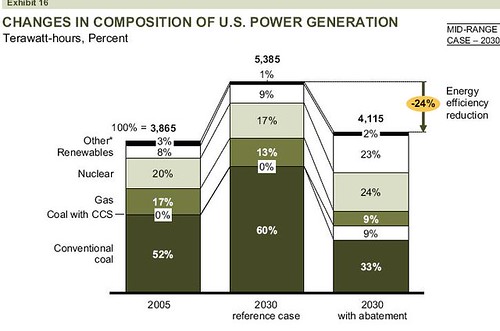
McKinsey projected energy mix
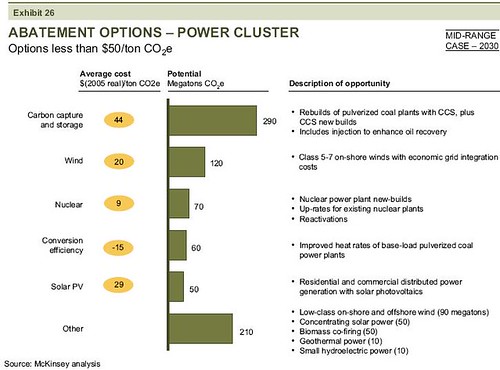
McKinsey analysis of power costs and contribution. I think nuclear can do a lot better. Note: McKinsey also thinks that nuclear is the cheapest option other than increasing efficiency

Brian Wang is a Futurist Thought Leader and a popular Science blogger with 1 million readers per month. His blog Nextbigfuture.com is ranked #1 Science News Blog. It covers many disruptive technology and trends including Space, Robotics, Artificial Intelligence, Medicine, Anti-aging Biotechnology, and Nanotechnology.
Known for identifying cutting edge technologies, he is currently a Co-Founder of a startup and fundraiser for high potential early-stage companies. He is the Head of Research for Allocations for deep technology investments and an Angel Investor at Space Angels.
A frequent speaker at corporations, he has been a TEDx speaker, a Singularity University speaker and guest at numerous interviews for radio and podcasts. He is open to public speaking and advising engagements.


Comments are closed.